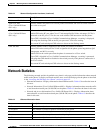
6-4
Cisco Unified IP Phone 6901 and 6911 Administration Guide for Cisco Unified Communications Manager 8.5 (SCCP and SIP)
OL-23874-01
Chapter 6 Monitoring the Cisco Unified IP Phone Remotely
Network Setup
Network Setup
The Network Setup on a phone’s web page displays network setup information and information about
other phone settings.
Table 6-2 describes these items.
You can view and set many of these items from the Network Setup Menu and the Phone Information
Menu on the Cisco
Unified IP Phone. For more information, see Chapter 4, “Configuring Settings on the
Cisco Unified IP Phone.”
To display the Network Setup area, access the web page for the phone as described in the “Accessing
the Web Page for a Phone” section on page 6-2, and then click the Network Configuration hyperlink.
UDI Displays the following Cisco Unique Device Identifier (UDI) information about the phone:
• Device Type—Indicates hardware type. For example, phone displays for all phone models
• Device Description—Displays the name of the phone associated with the indicated model
type
• Product Identifier—Specifies the phone model
• Version Identifier—Represents the hardware version of the phone
• Serial Number—Displays the unique serial number of the phone
Time Time obtained from the Date/Time Group in Cisco Unified Communications Manager to which
the phone belongs
Time Zone Time zone obtained from the Date/Time Group in Cisco Unified Communications Manager to
which the phone belongs
Date Date obtained from the Date/Time Group in Cisco Unified Communications Manager to which the
phone belongs
Table 6-1 Device Information Area Items (continued)
Item Description
Ta b l e 6-2 Network Configuration Area Items
Item Description
DHCP Server IP address of the Dynamic Host Configuration Protocol (DHCP) server from which the phone
obtains its IP address.
MAC Address Media Access Control (MAC) address of the phone.
Host Name Host name that the DHCP server assigned to the phone.
Domain Name Name of the Domain Name System (DNS) domain in which the phone resides.
IP Address Internet Protocol (IP) address of the phone.
Subnet Mask Subnet mask used by the phone.
TFTP Server 1 Primary Trivial File Transfer Protocol (TFTP) server used by the phone.
TFTP Server 2 Backup Trivial File Transfer Protocol (TFTP) server used by the phone.
Default Router 1 Default router used by the phone.
DNS Server 1 through 5 Primary Domain Name System (DNS) server (DNS Server 1) and optional backup DNS
server (DNS Server 2 - 5) used by the phone.


















